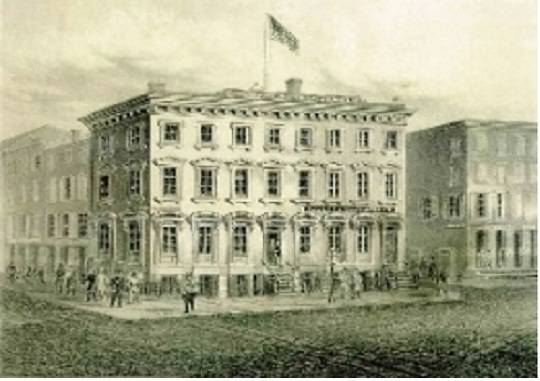India House Artwork Inspires New Book
By EVE M. KAHN
India House, a private club in Lower Manhattan founded 100 years ago, has removed much of the art it has displayed over the years, but related documents survive to entice researchers. The art historian Margaret Stocker, a trustee of the India House Foundation and a former curator atthe club, is writing a book about Asian and maritime art that has been onview there, while the pieces themselves have been going on the market.
Their provenances are tied to presidents, emperors and peaceactivists. Two of the club’s founders, Willard Straight and his wife, Dorothy Payne Whitney Straight, “wanted to bring East and West together through cultural diplomacy,” Ms. Stocker said in an interview. At her Manhattan apartment, India House relics include a light fixture painted with galleon silhouettes, portraits of shipping magnatesand vintage catalogs of India House exhibitions. She plans to call her book “Saving China’s Art: The Heiress, the Diplomat and the ‘American Emperor.’ ” The subtitle refers to the Straights and their friend Theodore
Roosevelt, who collaborated to raise awareness of Asian art and protect what was left in China.
India House has dispersed about 90 percent of the artworks and artifacts shown there.
In 2011 a bronze Chinese deity from India House sold at Christie’s in New York for $2.21 million. In September Christie’s auctioned a dozen Chinese vessels and deity statues in copper and bronze; the highest price paid was $147,750.
Last August Northeast Auctions of Portsmouth, N.H., sold three dozen paintings of ships and shipwrecks from the club. The top lot ($60,000) was William Bradford’s 1850s view of a Boston clipper ship.
India House was originally formed to foster international trade. The Straights and assorted shipping tycoons and industrialists commissioned its dining and gathering spaces in a mid-1800s former cotton exchange on Hanover Square.
Mr. Straight, although often suspected of having married to avail himself of his wife’s railroad fortune, was self-made. The son of teachers in Oswego, N.Y., he was orphaned by the age of 10. He graduated from Cornell and quickly rose to prominence in banking and diplomatic circles across Asia. He worked with American financiers, including J. P. Morgan and Edward H. Harriman, on loans to prop up the Chinese government, and Roosevelt appointed him consul general in Manchuria.
Mr. Straight collected art along the way, and he urged museums and dealers to stop buying plundered Chinese pieces. “Monuments are even being broken up by vandals,” the Asiatic Institute, which the Straights helped found, warned in 1914.
Mrs. Straight was a suffragist, philanthropist and art collector. By marrying Willard, she “spurned foreign noblemen and the pick of all the aristocratic clubs of New York,” a newspaper reported in 1911.
The newlyweds took a honeymoon train ride to Peking from Geneva. Soon after they settled into quarters within the Forbidden City, Ms. Stocker said that “looters ransacked their home and carried away their wedding gifts.”
The couple returned to New York. During World War I, Mr. Straight signed up for military service in France.
For more, please read the full article at: India House Artwork Inspires a New Book- NYTimes.com
 The Global Calcuttan Magazine
The Global Calcuttan Magazine 